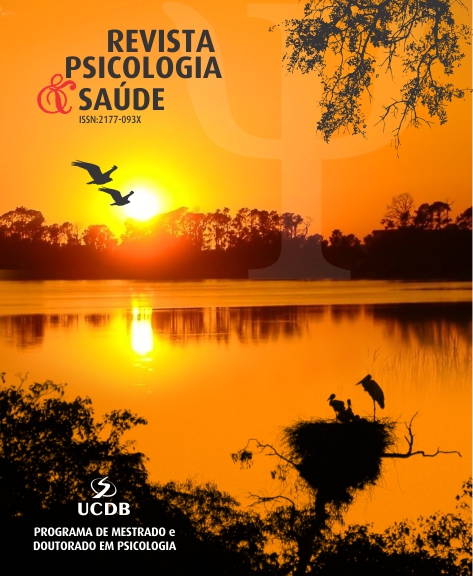Impacts of Bullying on Self-Esteem and Self-Image
DOI:
https://doi.org/10.20435/pssa.v14i4.1844Keywords:
bullying, physical appearance, self-esteem, self-image, genderAbstract
Physical appearance is one of the main aspects related to the experience of bullying, a violence that can affect the self-esteem of those involved. In order to investigate the occurrence of bullying motivated by physical appearance during adolescence and its impacts on the well-being of students through the levels of self-image and self-esteem, 107 college students retrospectively responded to a questionnaire. Of the totality of participants, 66.4% reported having suffered victimization, with emphasis on verbal, relational, and sexual violence. Factors such as weight, body shape, and hair were the most reported aspects of physical appearance related to the occurrence of violence, and 35.1% of the women indicated their gender. Participants obtained a high average for self-image and low for self-esteem, and those who were bullied had statistically lower scores than those who did not. Gender-sensitive bullying prevention interventions are needed.
References
Albuquerque, P. P. D., & Williams, L. C. D. A. (2014). Evidências de validade da escala “Student Alienation and Trauma Survey–R. Avaliação Psicológica, 13(1), 115–124. http://pepsic.bvsalud.org/scielo.php?script=sci_abstract&pid=S1677-04712014000100014
Andreolli, A. S., & Triches, R. M. (2019). Insatisfação corporal, bullying e fatores associados em adolescentes. Ciência & Saúde, 12(3), e33077. https://doi.org/10.15448/1983-652X.2019.3.33077 DOI: https://doi.org/10.15448/1983-652X.2019.3.33077
Bandeira, C. M., & Hutz, C. S. (2010). As implicações do bullying na autoestima dos adolescentes. Revista Semestral da Associação Brasileira de Psicologia Escolar e Educacional, 14(1), 131–138. https://doi.org/10.1590/S1413-85572010000100014 DOI: https://doi.org/10.1590/S1413-85572010000100014
Brito, C. C., & Oliveira, M. T. (2013). Bullying and self-esteem in adolescents from public schools. Journal de Pediatra, 89(6), 601–607. http://dx.doi.org/10.1016/j.jped.2013.04.001 DOI: https://doi.org/10.1016/j.jped.2013.04.001
Chocarro, E., & Garaigordobil, M. (2019). Bullying y cyberbullying:
Diferencias de sexo en víctimas, agresores y observadores. Pensamiento Psicológico, 17(2), 57–71. https://doi.org/10.11144/Javerianacali.PPSI17-2.bcds DOI: https://doi.org/10.11144/Javerianacali.PPSI17-2.bcds
Douglass, S., Mirpuri, S., English, D., & Yip, T. (2016). “They were just making jokes”: Ethnic/Racial teasing and discrimination among adolescents. Cultural, Diversity & Ethnic Minority Psychology, 22(1), 69–82. https://doi.org/10.1037/cdp0000041 DOI: https://doi.org/10.1037/cdp0000041
Gatto, R. C. J., Garbin, A. J. I., Corrente, J. E., & Garbin, C. A. S. (2017). Self-esteem level of Brazilian teenagers’ victims of bullying and its relation with the need of orthodontic treatment. Revista Gaúcha Odontologia, 65(1), 30–36. http://dx.doi.org/10.1590/1981-863720170001000053304 DOI: https://doi.org/10.1590/1981-863720170001000053304
Guimarães, J., & Cabral, C. S. (2019). Bullying entre meninas: Tramas relacionais da construção de identidades de gênero. Cadernos de Pesquisa, 49(171), 160–179. https://doi.org/10.1590/198053145708 DOI: https://doi.org/10.1590/198053145708
Hellstrom, L., & Beckman, L. (2020). Adolescents’ perception of gender differences in bullying. Scandinavian Journal of Psychology, 61, 90–96. https://doi.org/10.1111/sjop.12523 DOI: https://doi.org/10.1111/sjop.12523
Kubota, L. C. (2014). Discriminação contra os estudantes obesos e os muito magros nas escolas brasileiras. Instituto de Pesquisa Econômica Aplicada. http://repositorio.ipea.gov.br/bitstream/11058/2643/1/TD_1928.pdf
Malta, D. C., Mello, F. C. M., Prado, R. R., Sá, A. C. M. G. N, Marinho, F., Pinto, I. V., Silva, M. M. A., & Silva, M. A. I. (2019). Prevalência de bullying e fatores associados em escolares brasileiros, 2015. Ciência & Saúde Coletiva, 24(4), 1359– 1368. https://doi.org/10.1590/1413-81232018244.15492017 DOI: https://doi.org/10.1590/1413-81232018244.15492017
Malta, D. C., Stopa, S. R., Santos, M. A. S., Andrade, S. S. C. A., Oliveira, M. M., Prado, R. R., & Silva, M. M. A. (2017). Fatores de risco e proteção de doenças e agravos não transmissíveis em adolescentes segundo raça/cor: Pesquisa Nacional de Saúde do Escolar. Revista Brasileira de Epidemiologia, 20(2), 247–259. https://doi.org/10.1590/1980-5497201700020006 DOI: https://doi.org/10.1590/1980-5497201700020006
Matos, V. J. A., Silva, J. P, Santos, K. D. A., & Guimarães, V. M. A. (2020). Bullying, preconceito e autoestima: Discutindo as principais relações e distinções.
Psicologia Argumento, 38(102), 647–668. http://dx.doi.org/10.7213/psicolargum.38.102.AO03 DOI: https://doi.org/10.7213/psicolargum.38.102.AO03
Mosquera, J. J. M., & Stobäus, C. D. (2006). Auto-imagem, auto-estima e auto-realização: Qualidade de vida na universidade. Psicologia, Saúde & Doenças, 7(1), 83–88. https://www.redalyc.org/articulo.oa?id=36270106
Mosquera, J. J. M., & Stobäus, C. D. (2008). Auto-imagem, auto-estima e auto-realização na universidade. A docência na educação superior. Sete olhares, 2, 111–128.
Nogueira, M. A., & Albuquerque, P. P. (2021). Adolescência e saúde mental: Repercussões dos padrões culturais de beleza. Psicologia Revista, 30(1), 76-101. https://doi.org/10.23925/2594-3871.2021v30i1p76-101 DOI: https://doi.org/10.23925/2594-3871.2021v30i1p76-101
Oliveira, W. A., Silva, M. A. I., Mello, F. C. M., Porto, D. L., Yoshinaga, A. C. M., & Malta, D. C. (2015). Causas do bullying: Resultados da Pesquisa Nacional de Saúde do Escolar. Revista Latino-Americana de Enfermagem, 23(2), 275–282. https://doi.org/10.1590/0104-1169.0022.2552 DOI: https://doi.org/10.1590/0104-1169.0022.2552
Olweus, D. (1993). Bullying at school: What we know and what we can do. Blackwell Publishers.
Ortega, M. V., Lozano, J. J. M., & Tristancho, S. L. Z. (2016). Factores asociados al bullying en instituciones de educación superior. Revista Criminalidad, 58(2), 197–208. http://www.scielo.org.co/pdf/crim/v58n2/v58n2a08.pdf
Palmer, B. F., & Clegg, D. J. (2020). A Universally Accepted Definition of Gender
Will Positively Impact Societal Understanding,
Acceptance, and Appropriateness
of Health Care. Mayo Clinic Proceedings, 95(10), 2235–2243. https://doi.org/10.1016/j.mayocp.2020.01.031 DOI: https://doi.org/10.1016/j.mayocp.2020.01.031
Reis, S. A. D. (2010). Imagem corporal em pacientes com transtornos alimentares: Um auxílio no tratamento através da educação física. (Monografia de Conclusão de Curso, Universidade Federal do Rio Grande do Sul, Porto Alegre, Rio Grande do Sul, Brasil). https://lume.ufrgs.br/handle/10183/27764
Russo, L. X. (2020). Associação entre vitimização por bullying e
índice de massa corporal em escolares. Cadernos de Saúde Pública, 36(10), 1–12. https://doi.org/10.1590/0102-311X00182819 DOI: https://doi.org/10.1590/0102-311x00182819
Santos, I. F., & Silva, M. A. C. (2021). O corpo no Ensino Médio: Uma análise da percepção corporal dos estudantes do Rio de Janeiro. Journal of Physical Education, 32, e3205. https://doi.org/10.4025/jphyseduc.v32i1.3205 DOI: https://doi.org/10.4025/jphyseduc.v32i1.3205
Santos, J. A. D., Cabral-Xavier, A. F., Paiva, S. M., & Leite-Cavalcanti, A. (2014). Prevalência e Tipos de Bullying em Escolares Brasileiros de 13 a 17 anos. Revista de Salud Pública, 16, 173–183. https://doi.org/10.15446/rsap.v16n2.30302 DOI: https://doi.org/10.15446/rsap.v16n2.30302
Santos, M. D. J., Mascarenhas, M. D. M., Malta, D. C., Lima, C. M., & Silva, M. M. A. D. (2019). Prevalência de violência sexual e fatores associados entre estudantes do ensino fundamental – Brasil, 2015. Ciência & Saúde Coletiva, 24, 535–544. https://doi.org/10.1590/1413-81232018242.13112017 DOI: https://doi.org/10.1590/1413-81232018242.13112017
Silva, G. R. R., Lima, M. L, C., Acioli, R. M. L., & Barreira, A. K. (2020). Prevalence and factors associated with bullying:
Differences between the roles of bullies and victims
of bullying. Jornal de Pediatria, 96(6), 693–701. https://doi.org/10.1016/j.jped.2019.09.005 DOI: https://doi.org/10.1016/j.jped.2019.09.005
Steglich, L. A. (1978). Terceira idade, aposentadoria, auto-imagem e auto-estima. (Dissertação de Mestrado, Universidade Federal do Rio Grande do Sul, Porto Alegre, Rio Grande do Sul, Brasil).
Stobäus, C. D. (1983). Desempenho e autoestima em jogadores profissionais e amadores de futebol: Análise de uma realidade e implicações educacionais. (Dissertação de Mestrado, Universidade Federal do Rio Grande do Sul, Porto Alegre, Rio Grande do Sul, Brasil). https://www.scirp.org/(S(lz5mqp453edsnp55rrgjct55))/reference/ReferencesPapers.aspx?ReferenceID=1417799
Vaidakis, N. (2020). Conceptual controversies
regarding the terms
Gender and Sex. Psychiatriki, 31(3), 271–274. https://doi.org/10.22365/jpsych.2020.313.271 DOI: https://doi.org/10.22365/jpsych.2020.313.271
Published
How to Cite
Issue
Section
License

This work is licensed under a Creative Commons Attribution 4.0 International License.
The articles published on journal Psicologia e Saúde holds the copyrights of all texts published by it. Due to that, there is a demand for a letter of copyright cession (see Appreciation). The full reproduction of any article of this Journal in other publications, by any means, requires a written authorization of the Editorial Board. Partial reproductions of articles (abstracts, more than 500 words of text, tables, pictures and other illustrations, sound files) should have the written permission of the Editorial Board and the Authors.












